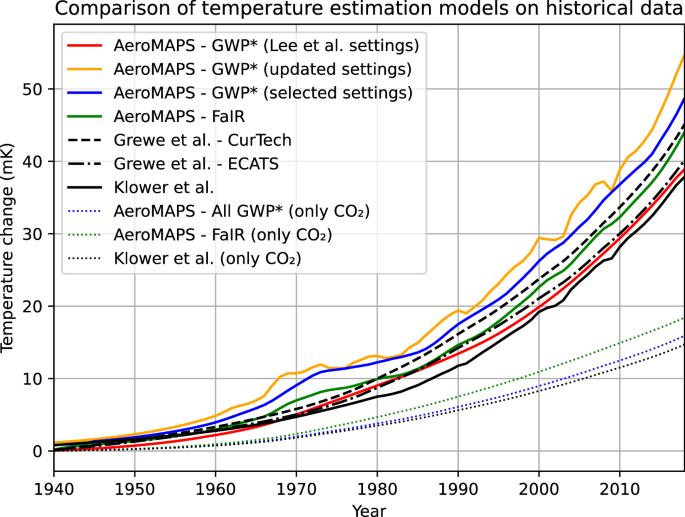轻量级气候模型有助于评估航空减排战略和超越二氧化碳当量指标的争论
IF 8.1
1区 地球科学
Q1 ENVIRONMENTAL SCIENCES
引用次数: 0
摘要
评估航空减排战略对航空利益相关者来说是一个关键问题,而关于最合适的二氧化碳当量指标以解决非二氧化碳影响的争论仍在继续。在此,我们提出了两种轻量级气候模型,可以通过参数化来评估这些策略,并超越二氧化碳当量指标的争论。第一种方法依赖于使用 GWP* 方法,第二种方法则使用 FaIR 气候模拟器。这些轻量级模型应被视为新的航空气候模型系列,有助于进行参数研究,为在温度水平上评估减缓战略提供了直接、一致的方法,尽管由于涉及重大的不确定性,它们在为决策者提供信息方面仍然有限。这些方法绕过了比较战略的二氧化碳当量指标的需要。后者应该用于其他用途,如鼓励战略出现的政策机制,因为它们不适合评估航空造成的温度变化。因此,关于二氧化碳当量指标选择的争论可以集中在方法论和道德标准上。不过,本文表明,交通流量越大,越应该选择高值的二氧化碳当量指标,以确保与气温估计值的一致性。本文强调了轻量级气候模型在评估航空减排战略方面的潜在用途,通过对两种可参数化方法的校准和验证,使这些应用超越了二氧化碳当量指标的争论。本文章由计算机程序翻译,如有差异,请以英文原文为准。

Lightweight climate models could be useful for assessing aviation mitigation strategies and moving beyond the CO2-equivalence metrics debate
Assessing mitigation strategies for aviation is a critical issue for the aviation stakeholders, while the debate continues on the most appropriate CO2-equivalence metrics to address non-CO2 effects. Here, we propose two lightweight climate models that can be parameterised to assess these strategies and move beyond the CO2-equivalence metrics debate. A first approach relies on the use of the GWP* method, while a second one uses the FaIR climate emulator. These lightweight models, which should be considered as a new family of climate models for aviation that facilitate parametric studies, provide a straightforward and consistent means of evaluating mitigation strategies at the temperature level, although they are still limited for informing policymakers due to the significant uncertainties involved. They bypass the need for CO2-equivalence metrics for comparing strategies. The latter should rather be used for other applications, such as policy mechanisms to encourage the emergence of strategies, as they are not suitable for assessing temperature changes from aviation. The debate on the choice of CO2-equivalence metrics could then focus on methodological and ethical criteria. However, this paper demonstrates that the higher the traffic, the more appropriate it is to choose CO2-equivalence metrics with high values for consistency with temperature estimates. The potential use of lightweight climate models for assessing mitigation strategies for aviation is highlighted, allowing to move beyond the CO2-equivalence metrics debate for these applications, according to the calibration and validation of two parametrisable methods.
求助全文
通过发布文献求助,成功后即可免费获取论文全文。
去求助
来源期刊

Communications Earth & Environment
Earth and Planetary Sciences-General Earth and Planetary Sciences
CiteScore
8.60
自引率
2.50%
发文量
269
审稿时长
26 weeks
期刊介绍:
Communications Earth & Environment is an open access journal from Nature Portfolio publishing high-quality research, reviews and commentary in all areas of the Earth, environmental and planetary sciences. Research papers published by the journal represent significant advances that bring new insight to a specialized area in Earth science, planetary science or environmental science.
Communications Earth & Environment has a 2-year impact factor of 7.9 (2022 Journal Citation Reports®). Articles published in the journal in 2022 were downloaded 1,412,858 times. Median time from submission to the first editorial decision is 8 days.
 求助内容:
求助内容: 应助结果提醒方式:
应助结果提醒方式:


